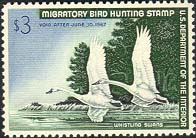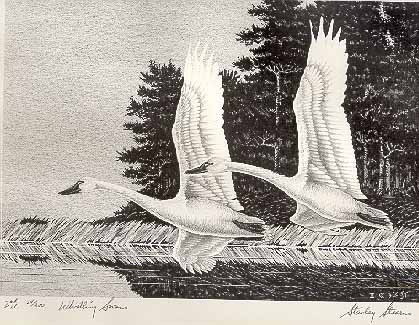

Back to RW33 Back to the Federal Index Home
A LITTLE HISTORY ON THE 33RD (1966-67) DUCK STAMP ARTIST


Mr. Stearns had begun etching only three years earlier when he decided to enter the Duck Stamp competition. He decided that etching was the proper medium for the prints and he set about getting all the supplies and equipment including a press, even though his only experience with etching was a brief exposure in art school. From the household he took a hair dryer, an old electric hotplate, and a kitchen fan to blow away the fumes of nitric acid. His manual for the project was a book on etching by Levon West, who later became a photographer under the pseudonym Ivan Smitri.
None of his equipment would fit into the room he was using as a studio; consequently, another bedroom was donated to the cause of art. For the next six months, the children’s bedtime baths had to be taken in the morning because the tub was being used afternoons and evenings to soak paper for the etchings. Mr. Stearns used a drawing of a moose standing in lily pads for his first three-by-five etching. The second, slightly larger was of Cinnamon Teal. A deer followed, larger yet. Finally he felt that he was ready to do Blue Geese, the largest of all and the one that won the Duck Stamp competition.
In 1961, the Stearns left the comforts of a home in suburbia and the security of a good job. They moved to Maryland where they could enjoy a milder climate and build their dreamboat. They ended up in a tiny cottage in the edge of the water surrounded by marshes of a major waterfowl area. With the children, the art supplies, and boat building paraphernalia, the house was far too small. They somehow managed, however, to make the difficult transition form outside employment to full-time fine artwork and still work on the boat. One of the most interesting jobs for Mr. Stearns, during that period, was that of art director for the national sailing magazine, The Skipper, in Annapolis. During the time of the boat building, Mr. and Mrs. Stearns each had four different jobs.
--------------------THE ART--------------------
Whistling Swans was painted with polymer paint using a wash and gouache technique. A stone lithograph was made and the prints were hand pulled. Black ink was used on white Rives heavy paper. The prints were hand signed and numbered in an edition of 300. Image size of the print is 7-1/2" x 10-1/2". This was Stanley’s third winning design.
--------------------THE STAMP--------------------
Whistling Swans…Engraved by the Federal Bureau of Engraving from the original artwork. Printed in black, blue, and green ink. The stamp sold for three dollars. Postal records show 1,804,783 stamps sold. First day of issue was July 1, 1966.
Most of the information contained above is from the book Federal Duck Stamp Story, Fifty Years of Excellence, by Laurence F. Jonson; Alexander & Co. It is used here with permission from the author. For more information on this book, please click here.